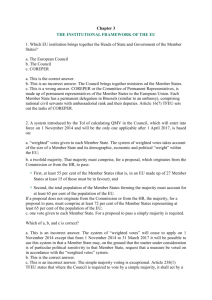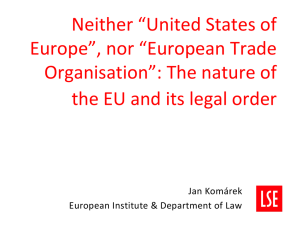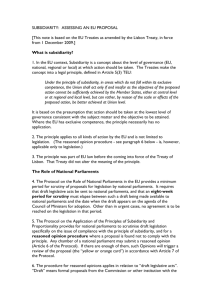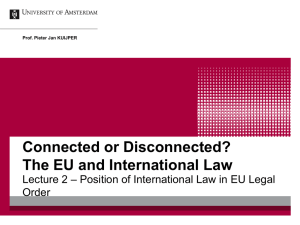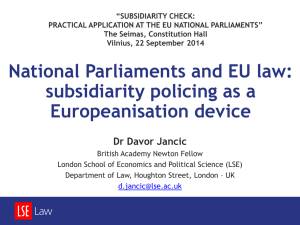– EU as a Polity
advertisement
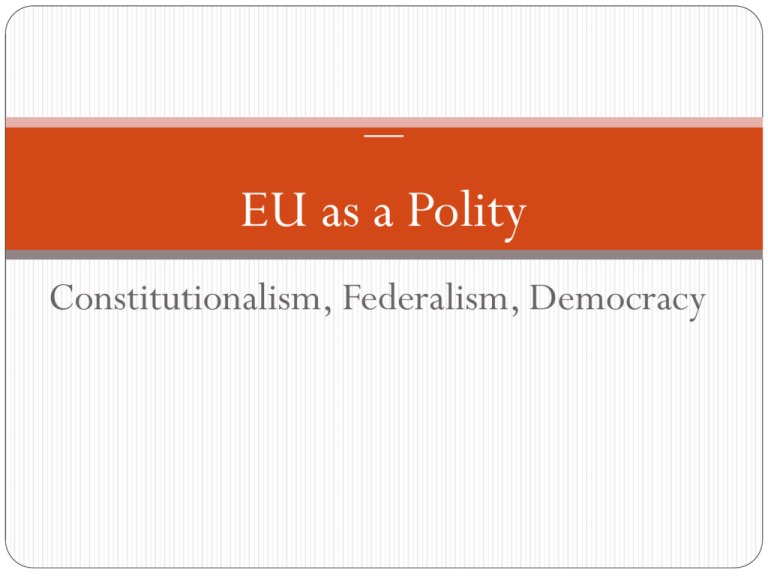
– EU as a Polity Constitutionalism, Federalism, Democracy How did the EU polity emerge? “[The Treaties] do not contain but a minimum of supranationalism and no danger of surprise can exist for the contracting states because nothing of substance can escape the control of the national parliament.” (The Report of Italian Senator Santero, presented in 1957 during the Italian ratification debates over the Treaty of Rome) In its highest ever fine on an EU state, the Court of Justice of the EU ordered Italy to pay 40 million Euros for failing to tackle the dumping of illegal waste. (December 2014) From intergovernmentalism to supranationalism Intragovernmentalism characterizes typical international organizations – national governments pursue their own interests and preferences that want to be allocated beyond the nation-state level Supranationalism implies that some powers resumed by the level beyond the nation-state are driven by the underlying political, economic and social processes and forces. Supranationalism in the current EU is exemplified by the qualified majority voting system in the EP and the Council, whereas intergovernmentalism is preserved in some fields such as: taxation, the accession of new states, and the common foreign and security policy – where unanimity still applies Question: At what point and how the EU turned from intergovernmentalism into supranationalism? Constitutionalization of the EU In terms of form, the primary law of the EU is international law, but in terms of substance, it is constitutional law. “The ‘constitutionalization of the treaty system’ refers to the process by which the Treaty of Rome has evolved from a set of legal arrangements binding upon sovereign states into a vertically integrated legal regime conferring judicially enforceable rights and obligations on all legal persons and entities, public and private, within EU territory.” (Stone Sweet) The process of constitutionalization began with the politics of judicial integration, conducted by the ECJ (today The Court of Justice of the EU) Initial stage: The vicious circle of ineffectiveness “The weaknesses of the European legal system fed upon itself. The lack of enforcement mechanisms discouraged the Commission from raising cases, and the lack of Commission cases allowed states to interpret the rules for themselves. The refusal of national courts to enforce European law or refer cases to the ECJ discouraged would-be litigants. Lacking cases, the ECJ was unable to develop jurisprudence, and the lack of ECJ jurisprudence left states significant latitude to interpret European law on their own. And the lack of any enforcement mechanisms discouraged the ECJ from making unpopular rulings against member states.” (Alter) Two phases of judicial integration First phase: 1962-1979 in which the ECJ secured the core, constitutional principles of supremacy and direct effect The doctrine of supremacy (Costa, ECJ 1964) lays down the rule that, in any conflict between an EU legal norm and national rule or practice, the EU norm must always be given primacy. Every legal rule coming within the purview of the Rome Treaty, from the moment of its entry into force, ‘renders automatically inapplicable any conflicting provision of . . . national law’ (Simmenthal II, ECJ 1978). The doctrine of direct effect holds that, under certain conditions, EU rules confer on individuals rights that public authorities must respect, and which must be protected by national courts. During this period, the ECJ found that certain treaty provisions (Van Gend en Loos, ECJ 1963) and a class of secondary legislation called directives (Van Duyn, ECJ 1974a) were directly effective, and it strengthened the direct applicability of another class of secondary legislation, called regulations. Two phases of judicial integration Second phase: 1980s onwards – the ECJ supplied national courts with enhanced means of guaranteeing the effectiveness of EU law. In the 1980s, the doctrine of indirect effect was established, according to which national judges must always interpret national rules as if they were in conformity with EU law (Von Colson, ECJ 1984). In Marleasing (ECJ 1990), the ECJ announced that, when a directive has either not been transposed or has been transposed incorrectly into national law, national judges are obliged to interpret this law in conformity with that directive. Finally, beginning with Francovich (ECJ 1991a), the ECJ has developed the doctrine of state liability. According to this doctrine, a national court can hold a member state liable for damages incurred by individuals due to a member state’s failure properly to transpose a directive. Federalization of the EU Once ‘constitutionalized’, the EU legal system has constituted and reinforced supranational modes of governance in the EU and reduced the impact of intergovernmentalism. Supranationalism implied the move towards a federal political system – this is genus proximus descriptive concept for various forms of political structures that are based on the combination of shared rule and self-rule (e.g. unions, federations, confederations, condominiums, hybrid political structures) In comparison to the US model of ‘constitutional federalism’, the EU ‘treaty federalism’ relies in the division of powers on the principle of subsidiarity. Principle of conferral “Under the principle of conferral, the Union shall act only within the limits of the competences conferred upon it by the Member States in the Treaties to attain the objectives set out therein. Competences not conferred upon the Union in the Treaties remain with the Member States.” (Art. 5.2 TEU) Principle of subsidiarity “Under the principle of subsidiarity, in areas which do not fall within its exclusive competence, the Union shall act only if and in so far as the objectives of the proposed action cannot be sufficiently achieved by the Member States, either at central level or at regional and local level, but can rather, by reason of the scale or effects of the proposed action, be better achieved at Union level.” (Art. 5.3 TEU) It applies only in areas where the Union and the Member States share legislative competence. This implies that the principle does not apply in areas where the Union has an exclusive legislative competence. It is not a rule for the allocation of competences, but for the use of competences Principle of proportionality “Under the principle of proportionality, the content and form of Union action shall not exceed what is necessary to achieve the objectives of the Treaties.” (Art. 5.4 TEU) The Goldilock and the Three Bears Principle: "Not too big, not too small, but just right“ The discussion of subsidiarity tends to be intertwined with issues of proportionality and purely political considerations. This may happen both at the legislative level, and when the issue of subsidiarity is argued before the ECJ. Interplay between the principles of conferral, subsidiarity and proportionality Subsidiarity and proportionality are corollary principles of the principle of conferral. They determine to what extent the EU can exercise the competences conferred upon it by the Treaties. By virtue of the principle of proportionality, the means implemented by the EU in order to meet the objectives set by the Treaties cannot go beyond what is necessary. The Union can therefore only act in a policy area if: 1. the action forms part of the competences conferred upon the EU by the Treaties (principle of conferral); 2. in the context of competences shared with Member States, the European level is most relevant in order to meet the objectives set by the Treaties (principle of subsidiarity); 3. the content and form of the action does not exceed what is necessary to achieve the objectives set by the Treaties (principle of proportionality). Subsidiarity as a safeguard of federalism The functioning is determined by Protocol No. 2 on the Application of the Principles of Subsidiarity and Proportionality Subsidiarity as a political and as a judicial safeguard of federalism Ex Ante Control by National Parliaments: Protocol will strengthen the political safeguards of federalism by involving the national parliaments as “watchdogs of subsidiarity” (a quasi-federal-second-chamber function); yet, national parliaments do not possess the veto power The Subsidiarity Protocol to the Lisbon Treaty (Protocol No 2) has its system with yellow card and orange card procedures (but no true red card procedure) allowing national parliaments to submit reasoned opinions with specific legal effects, when they believe that a Commission proposal for new EU legislation violates the Subsidiarity Principle. Ex post Judicial Control by Union Courts: “The Court of Justice of the European Union shall have jurisdiction in actions on grounds of infringement of the principle of subsidiarity by a legislative act…” (Art. 8 of the Protocol); judicial safeguard gives the Court a quasi-federal-constitutional-review function ‘Withdrawal Clause’ and the EU federalism Friel argues that withdrawal (secession) mechanisms in federal political a) b) c) systems may fall into three principal categories: State primacy, in which there exists an absolute, immediate, and unilateral right of a Member State to withdraw from the federal polity; Federal primacy, which implies absolute prohibition of a Member State’s withdrawal; Federal control, where a Member State retains its sovereign right of withdrawal, but subject to negotiations with and approval by remaining units of the federal polity “Any Member State may decide to withdraw from the Union in accordance with its own constitutional requirements.” (Art. 50TEU) However, in case of a dispute as to the validity of the Member State’s decision to leave the EU, the question as to whether or not the decision was constitutionally made would fall ultimately to the Court of Justice of the EU. EU –What sort of a political system? Maastricht Treaty was a decisive step towards political integration of Europe In its famous 1993 Brunner Case on the Maastricht Treaty, the German Federal Constitutional Court stated that the European Union is neither a classical federal state (Bundesstaat), nor a mere alliance of sovereign states (Staatenbund), but a sui generis polity – Staatenverbund. “The EU is a political system in its own right, or at least a ‘partial polity’.” (Beetham and Lord); it is “a polity without a state” (Brunkhorst); it is “a political system as it possesses all the elements needed to be such a system: institutional stability and complexity; powers of government through which citizens and social groups seek to achieve their political desires; a significant impact on the distribution of economic resources and the allocation of social and political values; and a continuous interaction between political outputs, new demands on the system, and so on.” (Gerven) EU as a democratic political system? According to Hix, there are four essential characteristics of all democratic political systems: 1. There is a clearly defined set of institutions for collective decisionmaking and set of rules governing relations between and within these institutions. 2. Citizens seek to achieve their political desires through the political system, either directly or through intermediary organizations like interest groups and political parties. 3. Collective decisions in the political system have an impact on the distribution of economic resources and the allocation of social and political values across the whole system. 4. There is a continuous interaction between these political outputs, new demands on the system, new decisions, and so on. Hix concludes that the EU possesses all these characteristics Challenges to the Political Integration of the EU Post-Maastricht, Brunner Case before the BVfG (1993), three interconnected findings of the Court: 1. Since democracy presupposes the existence of a demos, no polity could be considered democratic unless its population does not display some expressive features of the common belonging to this polity; 2. The EU can transform into a democratic polity primarily by moving towards some traditional nation-state model in which the aforementioned concept of democracy is more easily attainable; 3. Legitimacy of the EU institutions and its decisions should be measured solely by standards of the traditional concept of democratic legitimacy. any claim of the European bodies that they possess the competence to determine the scope of its competence (Kompetenz-Kompetenz) could not be validated in German law BVfG’s Decision on Lisbon Treaty (June 2009) The structural problem of the European Union - in some fields of policy, the European Union has a shape that corresponds to that of a federal state, i.e. is analogous to that of a state, whereas the internal decision-making and appointment procedures remain predominantly committed to the pattern of an international organization, i.e. are analogous to international law. Overcoming the ‘structural problem’? “As long as, consequently, no uniform European people, as the subject of legitimization, can express its majority will in a politically effective manner that takes due account of equality in the context of the foundation of a European federal state, the peoples of the European Union, which are constituted in their Member States, remain the decisive holders of public authority, including Union authority.”
